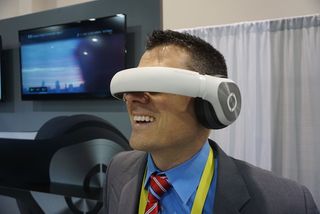Avegant Glyph: Sleek Heads-up Display Meets Headphones
Avegant has released the design of its personal theater headset, which mashes together a heads-up display with Beats-like headphones.

LAS VEGAS -- Unlike other heads-ups displays, the Avegant Glyph isn't about inserting you into a virtual world or -- more importantly -- making you look like a cyborg. This personal theater, which got $1.5 million worth of love on Kickstarter, combines an immersive experience for your movies and games in a device that doubles as noise-canceling headphones.
At CES 2015, this startup unveiled the consumer design for its hybrid gadget, which will cost $599 when it goes on sale (but $499 if you order before Jan. 15). We took it, as well as a less refined prototype, for a spin to get a feel for the user experience. While exciting, it's definitely still a work in progress.
The latest (non-functioning) iteration of the Glyph design reminds of Beats headphones -- in a good way. They look like a slightly chunky set of premium cans, with smooth white plastic and chrome accents. The headband conceals the optics, which you'll be able to easily slide down toward your eyes. Using two sliding diopter controls on the bottom front portion of the gadget, you can adjust the picture for the best viewing experience. We're talking about an 80-inch screen in front of your face.

MORE: Most Anticipated Games of the Year
But that screen's not right in front of your face. Avegant stresses that its micromirror retinal-projection technology delivers a more movie-theater-like experience, which took some getting used to when I donned the latest functioning prototype. It was as if the Beach Buggy Racing game I was playing on my iPhone 6 was far away. I could see myself enjoying movies more with the Glyph than I would apps and games, but I might change my mind as I use the headset more.
Playing touchscreen games will prove challenging with the Glyph, as you can't see through the device to your fingers, but I found the racing game fairly easy to control because it's mostly tilt-based. However, those gamers who have memorized the physical layouts on their controllers -- be it Xbox One, PS4 or PS Vita -- likely won't feel a disconnect.
I noticed some visual tearing in the picture quality, with black lines appearing across the screen as I played, but I'm assuming that will be ironed out as the Glyph gets closer to launch. What will continue to be an obstacle is the need for an HDMI adapter for mobile devices. It felt a little kludgy needing an accessory between my iPhone and the Glyph. Plugging the device into devices with full-size HDMI ports, such as gaming consoles and laptops, will be more seamless.
Sign up to get the BEST of Tom’s Guide direct to your inbox.
Upgrade your life with a daily dose of the biggest tech news, lifestyle hacks and our curated analysis. Be the first to know about cutting-edge gadgets and the hottest deals.

On the audio front, the Glyph supports Bluetooth, so you won't need more than one wire coming out of the device at any given time. Plus, it supports active noise canceling. Even in a noisy part of the Sands convention center of Las Vegas, the booming audio of the Glyph blocked out the racket around me.
Avegant promises three to four hours of battery life for the Glyph, which is plenty of time to sit through a Lord of the Rings flick on your next flight.
Outlook
Overall, the Glyph is a pricy but promising piece of futuristic tech. I might not wear them on a subway, but I wouldn't be afraid to don them on a plane, which is a tribute to Avegant's design team. I'd take the Glyph over that crappy airline seat screen any day.
Mark Spoonauer is the global editor in chief of Tom's Guide and has covered technology for over 20 years. In addition to overseeing the direction of Tom's Guide, Mark specializes in covering all things mobile, having reviewed dozens of smartphones and other gadgets. He has spoken at key industry events and appears regularly on TV to discuss the latest trends, including Cheddar, Fox Business and other outlets. Mark was previously editor in chief of Laptop Mag, and his work has appeared in Wired, Popular Science and Inc. Follow him on Twitter at @mspoonauer.

